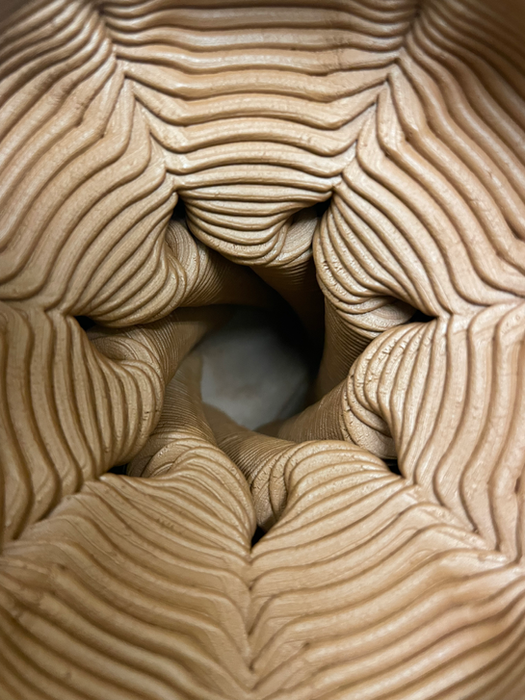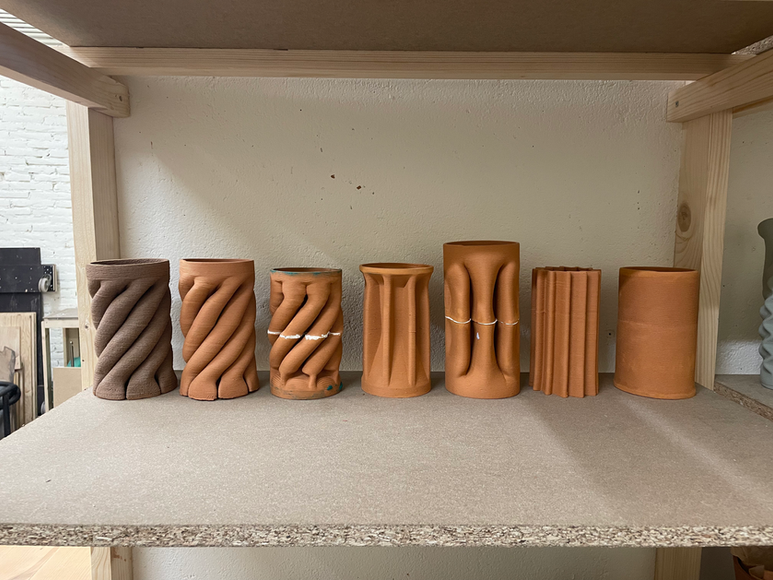Resource. Society.
Resource.Society was initiated within the Hungry EcoCities residency, a EU funded program that brings together artists and innovators to rethink the relationship between food, cities, and technology. The collaboration with InstaGreen (Barcelona) provided both a real-world context and a testing ground. InstaGreen’s hydroponic farms are compact, modular systems used to grow microgreens in urban settings. They already embody a sustainable approach to local food production, but like all Controlled Environment Agriculture (CEA), they have to rely on electric climatization. Cooling and dehumidification demand considerable amounts of energy, which can become unsustainable for small-scale farms.
The project set out to ask a simple but radical question: can indoor farming spaces regulate climate more like living organisms than machines?

Research Vision
The artistic mission is to imagine buildings as living membranes. Climate control should not be hidden in ducts and machinery, but expressed through surfaces that visibly interact with their environment. Just as skin regulates sweat and lungs regulate breath, walls or pipes could regulate humidity and temperature. Such an approach makes function visible, turning farms and buildings into expressive systems that reveal their ecological role.
Indoor farming spaces are often treated as sealed, independent environments, disconnected from the outdoor climate. This allows food to be grown in places where it would otherwise be impossible, but it also makes them highly dependent on electricity to maintain artificial conditions. Analysis of outdoor data, however, shows that there are often moments when outside conditions could passively support the indoor climate. The challenge is how to use those moments without exposing the farm to unwanted influences.
For this reason, the system was designed with two essential abilities:
-
Selectivity – the capacity to interact with temperature and humidity independently, since often only one of the two is favorable at a given time.
-
Control – the capacity to stop interaction when outside conditions are not favorable.

Small-Scale Experiments
To ground these ideas in practice, a series of sealed box experiments were set up. Each box contained microgreens, an LED light, sensors, and a prototype climate-control element. This small-scale environment allowed precise measurement of how different materials and forms influenced temperature and humidity.
Clay Tubes for Dehumidification
The first series tested 3D-printed clay tubes that connected the inside of a box to the outside air. Different shapes were designed: simple straight tubes, venturi-shaped necks, and spiral vortex forms. The hypothesis was that increased surface area and turbulent airflow would improve the rate at which humidity could pass through the clay wall.
The results confirmed this: the vortex and venturi shapes clearly removed moisture more effectively than the plain tube. The control box without any tube saturated at nearly 100% humidity within minutes, while the shaped tubes managed to hold levels significantly lower.
At the same time, an important limitation appeared. Even the best-performing clay designs would require very large surface areas to dehumidify an entire grow room. Clay could work, but not on its own.
Fabrics as Membranes
The next step was to test textile membranes. Tubes were made from cotton, linen, viscose, and a technical fabric (Sympatex®). Each was mounted to a test box and monitored under controlled temperature differences. The results showed that textiles could move humidity much more efficiently than clay. Sympatex stood out: not only was it recyclable and airtight, it also allowed high vapor transfer. This meant that humidity could be released to the outside without any unwanted heat exchange.
Clay Tubes for Cooling
Clay was then reintroduced, but this time for evaporative cooling. When water was added to the inside of the 3D-printed tubes, evaporation absorbed heat from the passing air, lowering its temperature. The same shapes that improved dehumidification also improved cooling performance. Material experiments followed: adding cellulose to the clay mixture created microscopic pores after firing, which improved water retention and evaporation. Mixing in copper powder slightly improved heat transfer. Tests showed that the porous clay was especially effective, confirming that the material itself could be optimized as well as the form.





These requirements led to the development of pipe-shaped elements equipped with small fans. When the fan is switched on, indoor air passes through the pipe, and its heat or humidity can interact with the outdoors across the pipe wall. When switched off, the pipe closes, preventing unwanted exchange.
At the center of this design is a Grasshopper-based tool, which calculates how much surface area and which material properties are needed to balance humidity and temperature inside a farm. The tool draws on local climate data and plant behavior, especially the water released through transpiration. By separating two flows, the system responds to each environmental factor independently:
-
Fabric membranes allow water vapor to escape without losing heat.
-
Clay structures transfer heat without passing vapor.
Together, these systems sketch the outlines of an architecture that does not fight the environment but works with it.
With these lessons in hand, the first full-scale prototypes were prepared for testing in InstaGreen’s Barcelona farm:
-
A ceramic evaporative cooling tube, 3D-printed from clay mixed with cellulose.
-
A fabric membrane tube dehumidifier, sewn from Sympatex.
The Barcelona context provides a particularly tough testing ground. Summers are hot and humid, and the InstaGreen farm is located underground, where indoor air can actually be cooler than the outside. This makes simple ventilation ineffective.
To identify the most effective strategies, several programs were coded to compare different climatization approachesand analyze the potential of passive systems. This required sourcing and processing a large amount of climatic data from the InstaGreen grow room, allowing the behavior of the plants and the influence of the hydroponic shelves on the surrounding space to be quantified.
The climatic analysis shows clear potential for the prototypes: the ceramic tubes cool by circulating outdoor air and water through their insides, while the fabric membrane can steadily moves humidity whenever a vapor pressure gradient exists. Future test aim to validate the simulated and small scale tests in the growing environment. To be continued!









